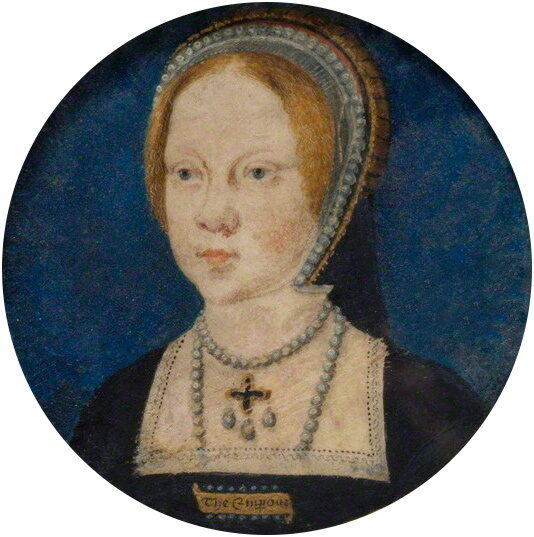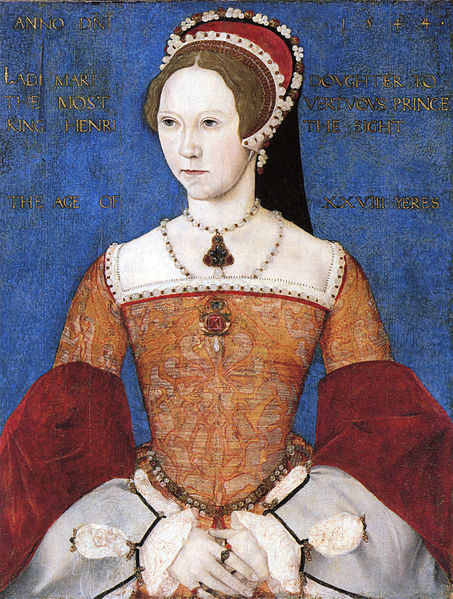There had never been a regnant queen in England before 1553, when Mary I ascended to the throne following the death of her younger brother Edward VI. After the death of our flame-haired monarch, Elizabeth I, a female ruler would not succeed to the throne until 1688 when Mary II was crowned alongside her husband William III, succeeded by Mary’s younger sister Anne, in 1702.
So what would a Queen of England in the early modern period have to do? Well, first thing’s first, they had to legitimise their rule by having a good ol’ fashioned traditional coronation.
The Coronation
 Far more angelic looking that her reputation!
Far more angelic looking that her reputation!
Source: MaryTudor.blogspot
When Mary Tudor ascended to the throne, the ritual of the coronation faced an unprecedented and profound challenge; how to induct a woman into what had only ever been a man’s role, in an era when women were regarded as the inferior sex? And in a society where female rule was seen as abnormal to God’s wishes. And furthermore, seen as a perversion of the patriarchal ordering of society (*rolls eyes*).
Well, the truth is, coronation’s provided queens with one of the first and most important opportunities to present their queenship to their new subjects and the European stage of politics.
In 1553, for the first time in history, an English coronation had do three key things:
- Address the concept of gender
- Reinterpret women’s inferiority in order to construct an image of queenship, hence marking their female status as acceptable
- And thirdly, elevate the office of queen to that of king.
How Did They Address The Issue of Their Gender?
I have listed the top ways women proved that their having the ability to grow a human inside them wouldn’t hinder their ability to rule their kingdom…
1. Claim that you are a Roman/ Greek goddess or biblical heroine returned to earth…

Source: Wikipedia
In the pageants performed during Mary’s procession the day before her coronation, she was portrayed as both Judith and Tomyris. Judith and Tomyris were biblical heroines, who cut off the heads of pesky tyrants left right and centre. She was also portrayed as Pallas Athene, the daughter of Zeus and worshipped as the goddess of war who fought for just causes.
Elizabeth’s pageants portrayed her as Deborah; a figure of divine restoration for freeing the Israelites from the Caanan king Jacob thus implying Elizabeth freed England from the oppression of her sister’s Catholicism.
Meanwhile Anne in 1702 followed Mary I’s example and was celebrated in coronation poetry as Pallas Athene, implying she was a warrior goddess, ready to tell Louis XIV to stick his head where the sun don’t shine.
By casting queens in these divine roles, it was hoped that their people would accept them as exceptions to the rule that women were subordinate to men.
2. Claim that you are the glorious restorer of True Religion*…
*The ‘True Religion’ being Protestantism

Source: Wikipedia
Elizabeth, Mary II and Anne all continued their divine representation by being depicted as restorers of God’s true religion through poetry, portraits and the literature that surrounded their coronations. This was an important tactic. At the times of their coronations there was severe backlashes against Catholicism. Mary II’s husband William actually overthrew her Catholic father James II to take the throne for himself and his wife!
Mary I was portrayed as a Christian queen, but she wisely didn’t make any strong hints towards her plans to bring England back under the wing of the papacy. Instead she used more subtle methods to hint towards her wishes. She sneakily swapped the holy oil that she was anointed with for some that had been blessed by a Catholic priest and personally revised the coronation oath, removing all mention of “new religion”.
By claiming to be an instrument of God’s will, the Queen’s elevated themselves above mere mortals and again reinforced the idea that they were the exceptions to the rule of their gender.
3. Get yourself a sumptuous new wardrobe…

Source: Wikipedia
You know how it goes, any glitzy event you get invited to automatically means a new outfit is required. The coronations were no different and without any precedent for what a regnant queen should wear, Mary I, who loved jewellery and fashion, was in her element.
She chose the same colour as that of a king at his coronation; gold. She paired her gorgeous dress with a crown that was so laden with jewels that she had to keep holding it up! Elizabeth would reuse Mary’s dress 5 years later. Mary made sure her ladies in waiting were in red velvet, while Elizabeth and Anne of Cleves were ordered to wear silver, reinforcing Mary’s superiority.
Mary II and Anne too wore dazzling gold dresses. Anne even had her dress embroidered with diamonds, and fixed even more into her hair. Interestingly, all the women involved in the procession were ordered to leave their diadems void of jewels to make Anne seem all the more grander.
All four saved the best for last. They decided to have a quick costume change in Westminster Abbey, slipping into velvet gowns of deep purple. When they emerged from the service, appearing for the first time as anointed and crowned monarch, they carved out a new image of queenly power, saving the colour reserved for royalty for their triumphant exit from the Abbey.